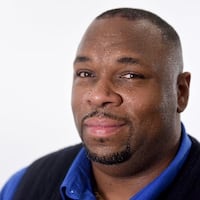The barbers at Visions Barber Shop off Covington Highway in Decatur have etched dozens of designs in the hair of little black boys and young men returning to school this month.
It’s a form of artistic expression, shop owner Dwight Buckner says, and at a price that doesn’t break the bank like a $200 pair of the latest shoes from basketball stars like LeBron James or Lonzo Ball.
“Every year, styles change,” said Buckner, also the senior pastor at Decatur’s Generation of Hope Church. “But they were doing this back in the ’70s and ’80s, with Mohawks, high-top fades. It’s doing anything different.”
But the designs have become the center of controversy for Narvie J. Harris Traditional Theme School, a DeKalb County School District school in Decatur, which has specific guidelines for how students can wear their hair. Parents said students have been disciplined for being too creative with their hairstyles. A photo that has been shared more than 10,000 times online shows pictures of hairstyles the school deems inappropriate. In the pictures, young black boys and girls don Mohawks, designs cut into their hair and braids with various colorful barrettes.
DeKalb County School District officials said the school's written policy does not reflect the district's guidelines, which do not address hairstyles. District officials said the school's hairstyle poster was taken down.
Requests seeking comment on the school’s policy were declined by district officials.
According to the school's policy, boys may not wear Mohawks or designs cut into their hair. Girls may not wear "unnatural" hair colors or barrettes of bright colors, only "clear, wooden, natural, maple, navy, hunter green or canary beads in hair."
Debbie Maddox read about the controversy online and did not understand the commotion over the school’s policy.
“You have to choose to put your child here,” said Maddox, whose children previously attended DeKalb County schools. “And it looks like this has been the policy forever.”
Maddox said she’s not a fan of every policy that exists at her daughter’s current school, but the rules were there before her child was. Many parents of current Narvie J. Harris students said they had no problem with the policy.
“I don’t agree with all of it, but that’s part of going to that school,” Maddox said. “If I’m going to continue to send my children there, we’re going to adhere to the policy.”
Shanita Burden said she has found herself at odds with the policy since her son began attending the school. A few years ago, she said then-principal Sean Tartt (now a regional superintendent) invited a friend to the school who would “fix” inappropriate hairstyles, which likely included cutting designs out of the hair and cutting Mohawks low. Last year, she said, her son was put in silent lunch — where students sit alone and are not allowed to talk during the lunch period — and threatened with in-school suspension for wearing the top of his hair in texturized curls.
“He thinks it’s cool,” she said of her son, whom she asked not be named. “It’s a way for him to feel trendy and part of the in-crowd. He thinks a regular haircut is boring. He’s 8.
“If he was Caucasian and his hair was naturally curly, would that be a problem?”
Black hair and expression through it is a centuries-old battle dating back to slavery, from slaves hiding their natural hair beneath wigs that looked more like white hair, to the Tignon Laws, which forced Creole women in Louisiana to wear scarves and handkerchiefs over their curls, to let others know they were "members of the slaved class," be they free or enslaved. In recent years, black women have fought to be able to wear their natural hair in corporate environments and while anchoring the news. It was only in the last decade that black women were given the right to wear braids in the military.
Different eras have popularized different hairstyles as black men and women sought to express themselves. Finger waves during the Harlem Renaissance. Afros in the black power movement. High-top fades in the ’80s. Buckner said the designs today are no different.
“They’re stereotyping kids through certain hairstyles,” he said, “and calling them troublemakers.”
Friday, Buckner’s two boys were with him at the barbershop as he cut hair from his chair near the shop’s front window. Like him, both boys had a short line cut into the right side of their hair.
“That one line to me is distinct,” he said. “That’s our thing. That’s how we like to express ourselves.
“If I had a D on the side of my head, they would, too.”
About the Author
Keep Reading
The Latest
Featured


